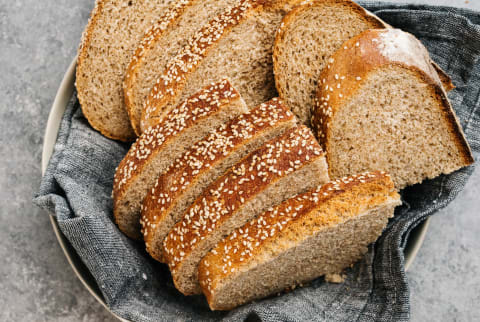Advertisement
Whole Wheat vs. Whole Grains: Dietitians Explain The Difference


Navigating the grocery store can be overwhelming, and one of the major points of confusion often lies in the bread and grain aisle. Pastas, breads, and crackers are often labeled "whole grain" and "whole wheat." But what do these titles actually mean, how are they different, and is one healthier than the other?
To help clear up the confusion, mbg spoke with registered dietitians and functional medicine doctors to see what they had to say.
What's the difference between whole wheat and whole grain?
The difference between whole wheat and whole grain is a matter of specificity, registered dietitian Maggie Moon, M.S., R.D., says. "Whole wheat is always whole grain, but whole grain doesn't always mean whole wheat."
Whole grains are grains that are minimally processed or completely unprocessed and still contain all three components of the grain's kernel. "The kernel contains the bran, endosperm, and germ," functional medicine doctor and registered dietitian Elizabeth Boham, M.D., M.S., R.D., tells mbg. "These germ and bran are rich in fiber, minerals, vitamins, and phytochemicals."
According to Moon, "These healthy components of whole grains make all the difference, and they're what's missing in white bread and pasta."
The only difference between whole grains and whole wheat is the specified type of grain. "Whole grains also include brown rice, steel-cut oats, and sorghum," Moon says, while whole wheat only applies to, well, wheat.
When looking for whole wheat bread, specifically, "the easiest way to decipher what's inside a loaf is to check out the ingredients," Moon says, noting the first ingredient should be whole wheat. "Watch out for breads labeled as multigrain, wheat, or stone-ground," Moon tells mbg. While those may contain some whole wheat, it's not always the sole ingredient. To be sure, Moon suggests looking for the whole grains stamp of approval from the Whole Grains Council.
What are the benefits?
"Whole grains, including whole wheat, are a fundamental part of a brain-boosting eating pattern, due to their antioxidants, essential minerals, and dietary fiber," Moon tells mbg. The recommended daily intake of grains is about 6 ounces for adult women and 8 ounces for adult men. According to the U.S. Department of Agriculture (USDA), at least half of those should be whole grains.
"The fiber in whole grains also works to slow down the absorption of your food and as a result decreases your blood sugar and insulin spike after a meal," Boham says. "These grains have a lower glycemic load when eaten in their whole form."
On top of that, whole wheat and other whole grains are staples in many heart-healthy, and metabolic-supporting diets, like the Mediterranean diet, Moon says.
Whole wheat vs. whole grain: Which is healthier?
Whole wheat contains gluten, which Moon says increases plant-based protein and contributes to the grain's chewy texture. That said, many people are sensitive or intolerant of gluten. Thankfully, there are plenty of naturally gluten-free whole-grain alternatives. This is one major reason someone might opt for whole-grain products over whole wheat. (Note: If you're following a gluten-free diet, always check the label to make sure what you're buying does not contain, or was not processed, with gluten.)
"Aside from that, the important thing is to enjoy a variety of whole grains because they each offer a unique bundle of nutrients, textures, and flavors," Moon says. Both whole-wheat and whole-grain products have plenty of fiber, minerals, vitamins, and phytochemicals, all of which contribute to a healthy, balanced diet.